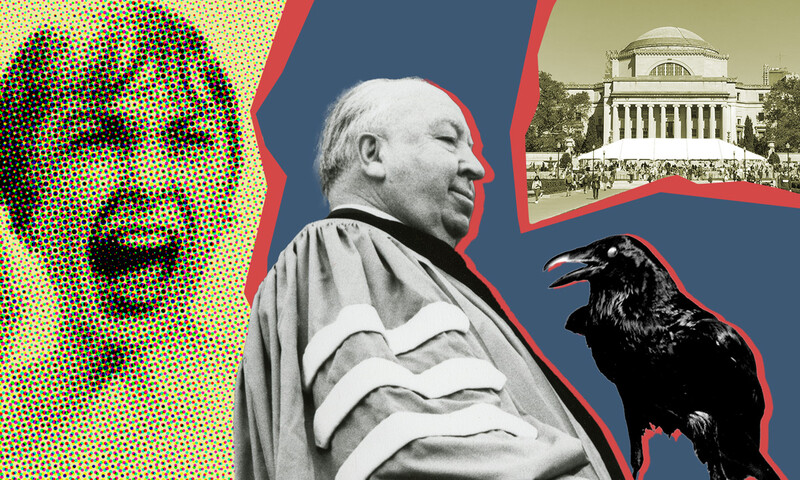Ad Reinhardt called them the “quietest” paintings, and even amid the din of a crowded opening, each one of the five all-black paintings on view in the new tower galleries of the Solomon R. Guggenheim Museum held viewers in thrall. Balance, subtlety, symmetry, a suggestion of the infinite: gripping. People stopped abruptly. They stood and stared, and took their time doing it. Perhaps transcendence is in, again.
One of the few American artists who began his career as an abstract painter, Reinhardt ’35CC is best known for the black paintings. His blacks are nearly identical in value, but in hue they range among greens, blues, and violets, and they become distinguishable only with time and contemplation. They are as close as he could come to absolute purity. “Art can only be defined as exclusive, negative, absolute, and timeless,” he wrote. “It is not practical, useful, related, applicable, or subservient to anything else.”
Yet the paintings currently on view at the Guggenheim are precisely in the service of the practical. Imageless: The Scientific Study and Experimental Treatment of an Ad Reinhardt Black Painting (up through September 14) is a show about art conservation as it relates to some of the most fragile paintings ever made: monochromatic, minimalist, smooth-surfaced works that can be ruined by a careless art lover’s lightest touch. For those unfamiliar with the stately pace of step-by-step scientific restoration, it is almost as fascinating as the paintings themselves.
“We hope to give people a better idea of what conservators do,” says Carol Stringari, Guggenheim’s chief of conservation. “It’s like solving a mystery.”
Born in Buffalo in 1915, Ad (short for Adolph, but he was, well, adamant that he be called only by the first syllable) studied aesthetics and art history at Columbia with Meyer Schapiro ’24CC, ’35GSAS, ’75HON, was on the wrestling team, and contributed cartoons, cover art, and writing to Jester, Columbia’s undergraduate humor magazine, where he was editor in chief his senior year. He was known for his wry wit. One of his Jester covers, cubist-inspired, depicts a muscular basketball player in a Columbia team jersey — in shades of pink. He became good friends with Robert Lax ’38CC and Thomas Merton ’38CC, ’39GSAS, and remained in touch with them after college. Merton became a Trappist monk and writer; Lax was a poet who retreated to the Greek island of Patmos for most of his life. All three were drawn toward spare simplicity in their work.
In the case of Reinhardt, who died in 1967, that simplicity made his paintings exquisitely fragile. The sixth painting in the Guggenheim show is Black Painting, 1960–66, and it’s not a pretty sight. For the past five years, under Stringari’s guidance, it has been subjected to scanning electron microscopy, backscatter electron X-radiology, krypton-fluoride lasers, and even traditional solvent techniques, which caused an eruption resulting in craquelure. A film in the exhibit documents the progress; we see Black Painting, 1960–66 being stabilized in a movable metal frame while a laser is applied, and various labels: “Pulse duration: 34 nanoseconds,” and “Spot size: 3.8 cm x 0.04 cm.”
It would be interesting to know what Reinhardt, who wrote dogmatically and sometimes abstractly about art, would think of the fate that befell Black Painting, 1960–66. Christiane Fischer, president and CEO of AXA Art Insurance Corporation, tells the tale: A private American collector lent the painting to a museum, and it was returned with “surface impact damage.” Several experts declared it a total loss. After the owner was compensated, the painting became the property of AXA, which decided to donate it to a “study collection” at a museum, where it would be used exclusively for research. AXA’s board also agreed to fund a position for a conservator to study the Reinhardt.
Beyond the surface impact, Black Painting, 1960–66 looked wrong to Stringari from the get-go. “It was shiny,” she says, whereas Reinhardt’s technique produced a soft matte surface. Scanning electron microscopy confirmed her worst fears: The painting had been “restored” before – with 11 layers over Reinhardt’s original nine. The later paint was acrylic (Reinhardt worked in oil) and sprayed on (he used brushes), and topped with a shmear of Rhoplex. Removing just the top layer from a 20-by-20-inch section with a laser took 24 hours. “The point is not to get there fast, but safely,” Stringari says. In the end, a non-Reinhardt layer will likely be allowed to remain, because the surface beneath it is considered highly unstable.
Another work, which Stringari casually refers to as “Frankenstein,” on the opposite wall, looks like a Reinhardt that’s been lacerated, lasered, and left in shreds, with numbered bits of tape sticking to it. Scary.
It turns out that Frankenstein is a creation of Stringari’s, but done according to Reinhardt’s strenuous, exacting technique, in which oil paint is shaken up in a jar with solvent and then left to settle. When the liquid is poured off, the pigment, soft and somewhat brittle from lack of binder, is then taken from the bottom and brushed by hand, layer after layer, in what Reinhardt called “brushwork brushed out to remove brushwork.”
Though the work is not a Reinhardt, Stringari believes it is a window into the artist’s process.
“We ask people to accept a potential compromise,” Stringari says. “All conservation is compromise. The goal is for the viewer to get closer to the experience of a Reinhardt. That’s what matters.”


